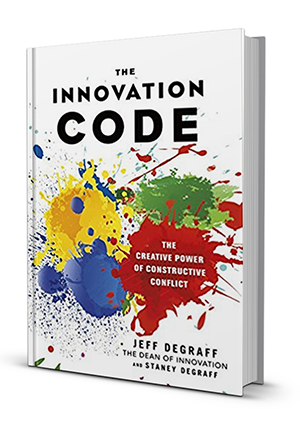Behind some of the twentieth century’s most iconic love songs is a series of prolonged, tense, irreconcilable conflicts. In the writing room and the recording studio, John Lennon and Paul McCartney were everything their music wasn’t: disharmonious, discordant, hostile. As professional partners, their worldviews couldn’t have been more different. Lennon, the Artist, was the nonconformist, always looking for the next big thing. McCartney, the Engineer, sought beauty by embracing order. Far from putting their differences aside, the diametrically opposed geniuses dwelled in the conflict. They didn’t fake accord for the sake of a peaceful working relationship. They were competitive with one another and pushed and pulled each other as they cowrote albums that managed to alternately highlight their divergent gifts. They didn’t compromise. They didn’t give in to the other. They elevated each other through their conflict. In seven years of constructive conflict, they wrote close to 200 songs and released 13 albums. The two men who made irresistible, genre-defining art out of the simple wish to hold your lover’s hand might’ve, under all other circumstances, very well preferred to be apart from each other.
This kind of constructive conflict is crucial in any creation process—not just for the collaborative production of art but for any degree of innovation in your life or your organization. And you don’t need to be a once- (or twice-) in-a-millennium virtuoso to cultivate constructive conflict.
In fact, there are concrete steps you can take to generate positive deviance in your innovation initiative. This isn’t to say that they’re easy and always guaranteed to work. Quite the contrary: this is a complicated process that takes long periods of practice and failing to finally find success. Like playing a piano, dwelling in conflict is a skill you need to try and try doing over again to perfect. And, in the process, it will take you to uncomfortable places. But that’s a discomfort—like the conflict itself—that you can and should dwell in. The very impulse to innovate comes from a negative feeling, a form of dissatisfaction: you’re unhappy with the present and so you want to make it better and new. Harness that dissatisfaction and make it into productive energy. As you work through that dissatisfaction, the discomfort will get greater before it lessens; the mess will get bigger before it becomes manageable. Don’t try to tidily clean up the mess. Get deeper in it and follow these steps:
- Assemble a diversity of perspectives
- Engage in the conflict
- Establish a shared goal or vision
- Construct hybrid solutions
Start with Lennon, end with McCartney. Innovation happens in phases, and at every moment, one viewpoint is more important than the other. No one can be fully effective at all phases of innovation. It’s crucial that you understand when each worldview should be put first.
Jeff DeGraff presents The Innovation Code
In the beginning, the Artist is likely to be the most important contributor. Her divergent point of view looks to the future and opens new possibilities. This is the moment when the Engineer should contribute least, as she’s likely to eliminate the wow factor of an innovation because her mind always goes to practical concerns, asking what’s actually possible. At the tail end of an innovation, when you need to bring the project to scale, the Engineer steps in as the driving force as her expertise with process and reliability becomes most important, and her talent for tinkering and improving things is vital. By this point, an Artist will likely have lost interest and be searching for the next avant-garde thing.
In the middle stages, Sages and Athletes are invaluable. A Sage negotiates, gets buy-in, and pushes the innovation through the organization, while an Athlete keeps the project on track, hits all the success measures, and grows momentum. These two need each other. Without the Athlete, the Sage is too busy bringing everyone along to hit important milestones. Without the Sage, the Athlete plows through without any buy-in or support.
One of the most important things about leading and managing innovation is keeping the team flexible and realizing when the current team configuration no longer produces the constructive conflict you need. Some team members can also burn out or can no longer contribute because of other commitments or assignments. Keep your network wide and platoon players in and out as you need them. Do not be afraid to try different combinations of people. Learn what makes the team work and create some rules that you can use for the future.
All innovations end. There is a natural end to any creative lifecycle. Brian Epstein’s death precipitated the breakup of the Beatles. Without the glue that held the band together, the man who helped the guys work through their conflict and maintain their shared vision, the band’s demise became inevitable. John became increasingly unsatisfied with the production of his songs and found inspiration in Yoko instead. A true Engineer, Paul wanted to make sure that the band continued to make good financial decisions without Epstein. But when he wanted to bring in a different manager, the others refused. Paul and John could no longer collaborate on songs. The constructive conflict was no longer sustainable.
The next problem and the next agents of constructive conflict that will power its solution: that’s the innovation afterlife. The hope is that if you’ve successfully created a culture of constructive conflict, where positive deviance is an everyday norm and the teams of people who practice it are ever-changing, you’re already looking toward the future.
Excerpted from The Innovation Code by Jeff and Staney DeGraff, Berrett-Koehler Publishers (August 2017)
The Innovation Code is a rigorous but highly accessible guide for achieving breakthrough solutions by utilizing the full—and seemingly contradictory—spectrum of innovative thinking.
